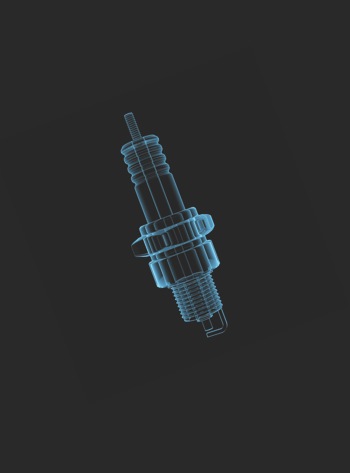
With the advent of electronic engine management systems, “reading” spark plugs has become something of a lost art. In the days of mechanical carburetors and distributors, the color and texture of the spark plug’s insulator could provide important information about the air/fuel ratio, spark timing and cylinder condition.
Back in the day, the desired insulator color was a light tan or gray, depending upon the brand of gasoline used. Over-rich fuel would produce a sooty, blackened spark plug while over-lean would produce a whitened insulator. Over-advanced spark timing would generally produce a glass-beading effect or salt-and-pepper texture on the insulator’s porcelain. Oil being consumed in small quantities through worn valve guides or piston rings would leave an encrustation or “scavenge” deposit on one side of the insulator, while excessive oil consumption would eventually foul the spark plug with a heavy layer of oil and black carbon.
Due to more accurate fuel and spark control, the spark plugs on modern engines generally appear in a like-new condition, even after many miles of use. But, when diagnosing spark plug failures, remember that modern fuel-injected engines are running at the thresholds of detonation and pre-ignition. While safeguards are built in, including misfire detection monitors and cylinder detonation sensors, engines can be severely damaged by installing spark plugs with an excessively high heat range.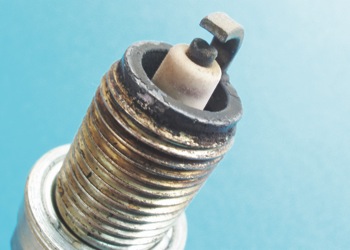
To complicate matters, operating a conventional engine on a highly oxygenated fuel like E85 gasoline will create an extremely lean air/fuel mixture, which can damage the spark plug and eventually damage the engine itself. In the following examples, I’ll get into a little more detail on the art and science of reading spark plugs.
Although it’s a perfectly normal condition, this spark plug (see Photo 1) is slightly darker than usual, indicating that the engine might not have been to full operating temperature and load before it was removed.
In any case, the center electrode is slightly rounded by normal erosion, while the ground electrode retains relatively sharp edges. Carbon accumulation on the steel spark plug shell is thicker than normal, which might indicate slightly more oil consumption than normal. If the spark plug heat range is too hot for the application, the center and ground electrodes will generally be prematurely rounded and the insulator will usually have a whitened, blistered appearance.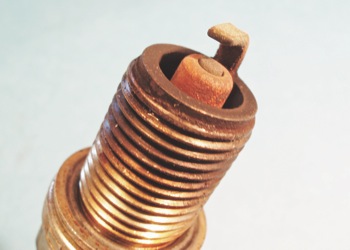
In contrast to the above photo, the air gap on the spark plug in Photo 2 is worn well beyond specification and both electrodes are rounded by erosion. For these reasons, this spark plug requires unusually high secondary voltages to ionize the air gap under full load. Secondary ignition failures, like perforated spark plug wire boots, perforated distributor rotors, carbon tracking in distributor caps and failed ignition coils, are often caused by excessively high 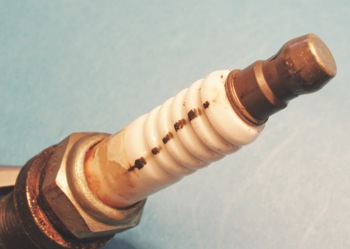 secondary ignition voltages.
secondary ignition voltages.
Although I’ve highlighted the flash-over on the spark plug insulator in Photo 3 with a marking pen for photographic purposes, flash-over or carbon tracking is a very common occurrence with high-voltage ignitions. Flash-over is basically caused by the ignition spark taking the path of least resistance. Spark plug electrode wear can increase to the point that the path of least resistance is down the side of the exterior insulator.
A path of least resistance can also be created by inadvertently leaving a greasy fingerprint or chemical residue on the spark plug insulator. Since a companion flash-over will be found in the spark plug boot, the wires or boot must be replaced.
To keep the spark plug insulator clean, form the habit of inserting the spark plug into a clean rubber spark plug installer or piece of rubber fuel hose as soon you open the box. This method 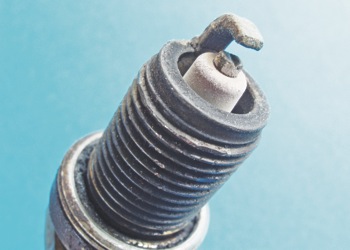 eliminates the possibility of contaminating the ceramic insulator.
eliminates the possibility of contaminating the ceramic insulator.
Under a magnifier, this spark plug appears to be coated with “glass beads” (see Photo 4), which are actually small bits of carbon blasted loose and melted when the air/fuel mixture in the cylinder detonates. Glazing is a similar condition that evenly coats the insulator with a shiny, glass-like coating, but is caused by a layer of soot melting under high combustion temperatures.
In contrast, the glass-bead effect is usually caused by detonation occurring when, under full engine load, the air/fuel mixture contained in a remote area of the combustion chamber self-ignites due to an extremely rapid rise in cylinder pressures. Detonation turns the normally progressive cylinder “burn” rate into a catastrophic explosion. Detonation can be caused by excessive spark advance, high compression ratios or low-octane gasoline. Mechanical symptoms of extreme detonation include broken spark plug insulators, piston lands and piston rings. 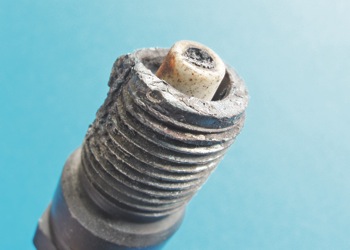
The missing “register mark” on the tapered seat of the spark plug in Photo 5 indicates that the seat was not contacting the cylinder head. Since the tapered seat conducts heat from the spark plug to the cylinder head, the spark plug over-heated and self-destructed.
In any case, over-heated spark plugs usually cause a pre-ignition condition because they tend to act like the glow plugs found on a model airplane engine. Pre-ignition occurs when the air/fuel mixture is ignited before the timed spark arrives at the spark plug. Due to the relatively long exposure to a hot flame front, the center of the piston weakens and, in most cases, a hole is driven through the center of the piston.
One or two cracked spark plug insulators from a set of spark plugs are generally consistent with leaking cylinder head gaskets. Much, of course, depends on the engine design.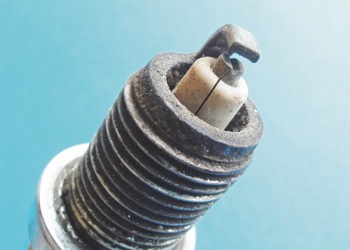
This spark plug in Photo 6 is from a 3.0L V6 engine found in many early ’90s-vintage Toyota 4Runners. Spark plugs like the above were often found at the right front cylinder and left rear cylinder due to the head gaskets most often failing at these points.
Remember that electrode temperatures approach 1,500° F operating temperature at full-throttle. A single drop of 200° F coolant striking this spark plug at higher engine speeds is sufficient to crack the insulator.












